How to make the perfect Boston baked beans – recipe
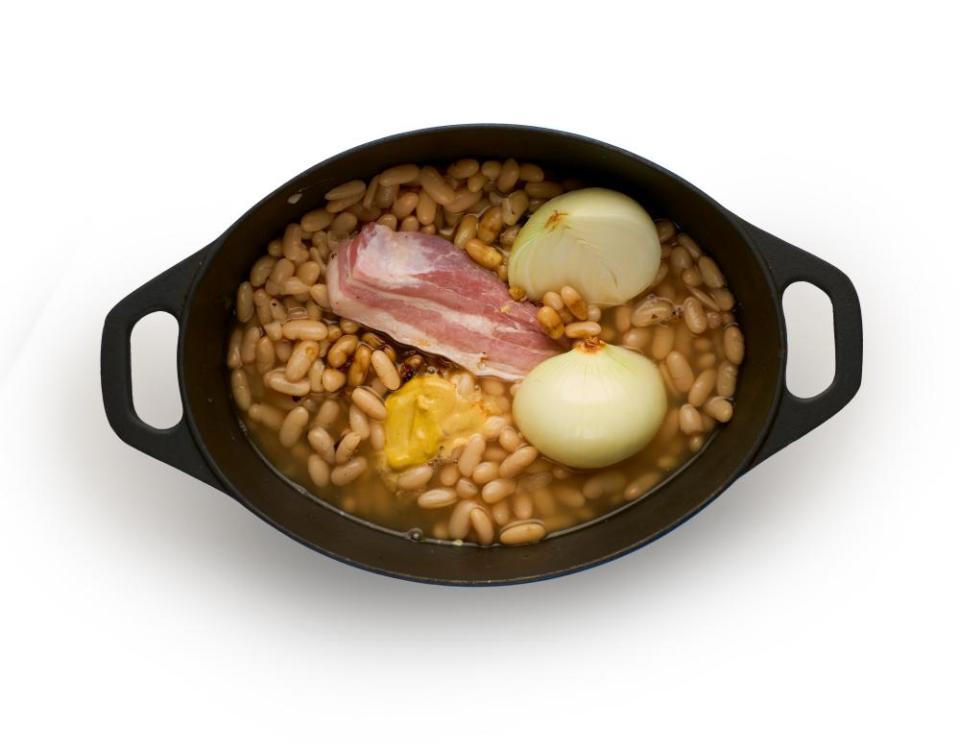
Sweet with molasses, tangy with cider vinegar and rich in pork fat, this indisputably American classic is packed full of flavour
Baked beans, but not as we know them – for all the tales of Native Americans “gifting” the notion to early European immigrants, there is (as yet) no evidence of them cooking beans in this way, and Keith Stavely and Kathleen Fitzgerald’s America’s Founding Food suggests that the “immediate progenitor” of this New England classic is more likely to have been a ham-flavoured pease pottage from Old England.
Whatever the truth, however, the beans – and the molasses used to flavour them – make this an indisputably American dish, and a useful one for those Puritans who kept the Sabbath holy, because it could be prepared on a Saturday and, according to Eleanor Early’s 1954 New England Cookbook, taken from the oven on Sunday morning for breakfast, before being returned there to keep warm for their return from church.
The mind boggles to think of the cumulative effect of such a bean-heavy diet on a household, but at least these baked beans, sweet from molasses, tangy with cider vinegar and rich with pork fat, are more of a balanced meal than our own beloved turquoise tins – rather like an American cassoulet, in fact, and just as worthy of your time in the kitchen. Though, actually, the oven does most of the work.
The beans
Let’s start with the easy bit. Early mentions tend to be fairly non-specific as to which variety to use, though white peas and navy beans pop up in a few examples. Joe Yonan, who includes his own version of “an old Vermont family recipe” for New England baked beans in his book Cool Beans, prefers, “Jacob’s cattle or other plump, creamy beans, such as … borlotti or pinto”. Unsurprisingly, they’re fairly interchangeable after so long in the oven, so use whatever you have to hand.
The question of preparation is a more interesting one. Most writers soak the beans in cold water before use, so when I see that Yonan skips this step, I’m so unnerved I contact him on Twitter to check I’ve not missed anything. He confirms he rarely bothers unless he’s not sure how old the beans are: “It usually doesn’t speed things up enough to make it worth it, and I get more flavour and colour in the beans when I skip it.”
He does, however, suggest adding kombu, or dried kelp, which, I learn from Cook’s Illustrated magazine, apparently “neutralises difficult-to-digest small carbohydrates in beans” and, as a rich source of glutamates, “boosts bean flavour [and] also improves texture: pinto beans soaked and then cooked in water with a strip of kombu had soft skins and smooth interiors; soaked beans cooked in water alone were more grainy and tough”. This is, apparently, because the seaweed’s “sodium and potassium ions trade places with minerals in the beans to create a smoother, creamier consistency”. All you really need to know, though, is that it works. If you don’t happen to have kombu handy and don’t want to buy any for future bean cooking (it keeps for ages), then both Cook’s Illustrated (CI) and Yonan recommend soaking them with a tablespoon of coarse salt instead. Rather than making them tough, as culinary lore suggests, “the sodium in the salt solution replaces some of the calcium and magnesium in the bean skins, making them more permeable and resulting in more tender beans inside and out”.
Less scientifically, but equally usefully, Florence Brobeck’s 1937 New York Times piece on “Yankee cooks” explains that “any old-fashioned cook knows that the only way to tell when [the beans are softened] is to lift out a spoonful … and blow on them. If they’re done, the pale shells blow off.” At this point, you’re ready to turn down the heat and slow-cook them, just like those Sabbath-keeping Puritans.
(If you’re absolutely desperate for Boston baked beans, and don’t have a few hours to play with, you could do worse than trying the recipe using tinned beans in The Joy of Cooking, which requires only an hour in the oven – they lack the depth of flavour of the slow-braised variety, but they’re still pretty good.)
The meat
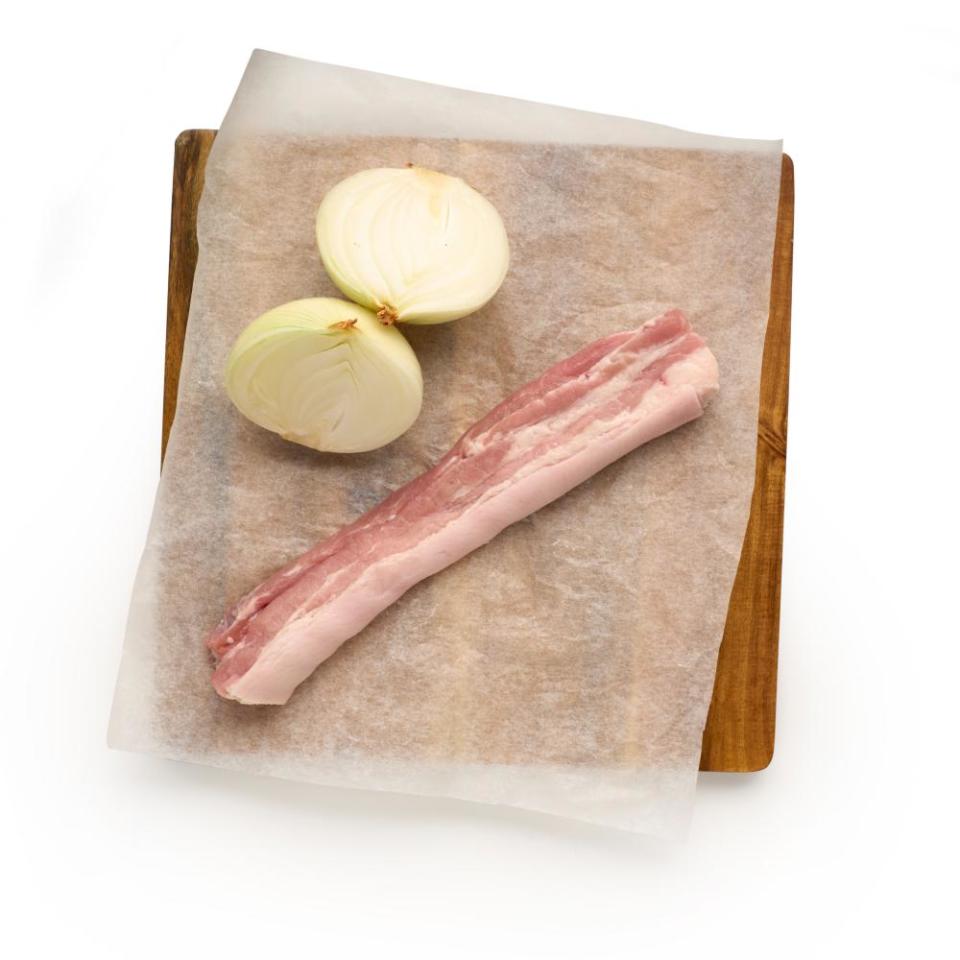
Early colonists had to stretch a little protein a long way, so the meat in Boston baked beans tends to be a fairly minor element, albeit one with a disproportionate importance to the finished dish, because the salt pork or bacon melts its fatty, savoury flavour into the sauce, which means Yonan has a challenge on his hands to make it plant-based. He gets away with it thanks to the judicious application of smoked paprika, though we do think his beans would be even better with a knob of butter (or some oil) stirred in at the end.
If you do eat meat, however, this is a very good dish to make the most of minimal amounts of it. As CI observes, salt pork, the traditional choice, can be so mild as to be underwhelming, while their testers found that smoked bacon was “too smoky and overwhelming” on its own – the two together, they decided, gave the perfect combination of heartiness and richness. As salt pork is not easily obtainable in the UK, I make a slab of my own from pork belly, a process that takes four days. Having done this, I feel able confidently to assure you that fat green streaky bacon makes a very good substitute – I don’t think you need the smoked sort, either, though feel free to use it instead if you prefer.
More important, in my opinion, is how you distribute it. Most recipes call for it to be cut into chunks, which dry out and disappear after so long in the oven, but Brobeck leaves it in a single slab, and “nestles” it amid the beans, so it ends up deliciously soft and tender, but still recognisably bacon. That said, many rashers are now cut so thinly that you may need to go to a butcher who slices their own, or make some salt pork, or stick a few slices together and hope for the best.
Seasonings and aromatics
Onion, though “a controversial ingredient in classic recipes”, according to CI, adds savoury balance to the sweetness of the mandatory molasses, so I’ll be including it – though, again, rather than chopping it into small pieces and browning it first, I’ll be adding it in halves, so it infuses the sauce. This saves you dicing something that, after five hours in the oven, is unlikely to be recognisable anyway, and also, I think, gives a more oniony end result.
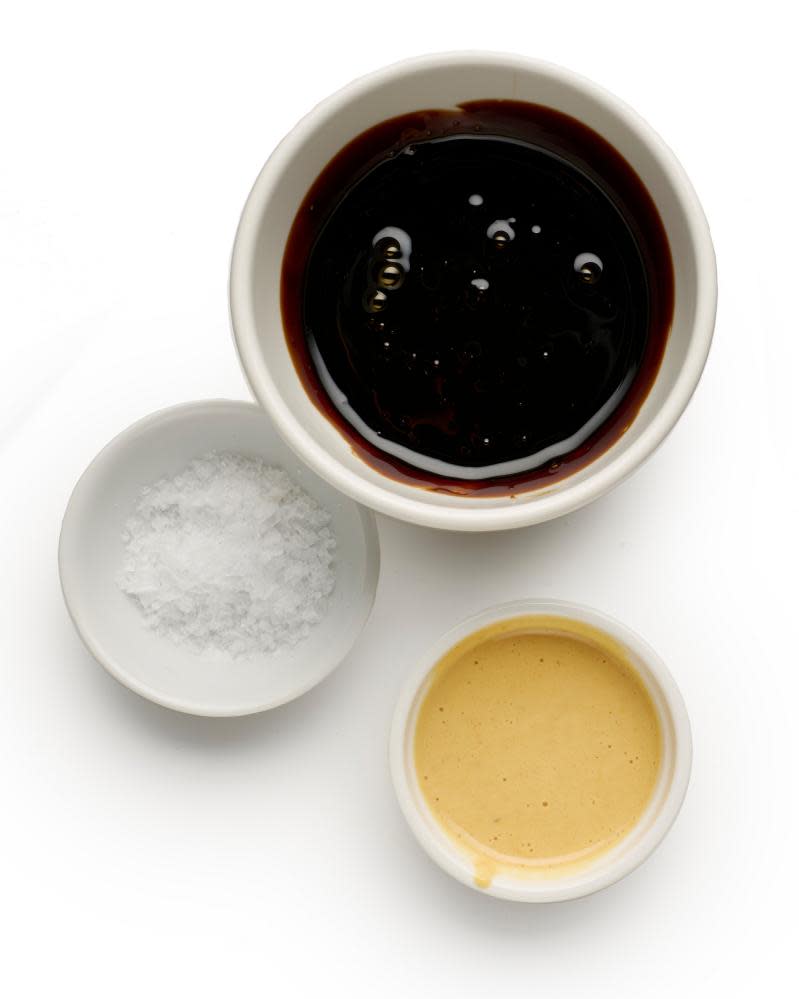
We all prefer the heat of mustard to the faintly British-tasting sweet-and-sour ketchup in The Joy of Cooking recipe. I’m unable to track down any brown mustard, which CI recommends for “imparting a pleasant sharpness without drawing attention to itself” – it seems to have disappeared from shelves here – so I try wholegrain instead, but, as with Daniel Gritzer’s take for Serious Eats, which uses tangy dijon, I miss the fire of the English mustard in Yonan and Brobeck’s recipes.
That said, I like wholegrain enough to add a little at the end instead, along with the cider vinegar essential for cutting through the sugar of the molasses. As for those molasses, which is the ingredient that gives New England baked beans their characteristic bittersweet note, it’s easily found in healthfood shops and online, but you can substitute the more one-dimensional treacle if you don’t want to invest in a jar. Yonan also uses maple syrup, but I’d prefer my beans to be less sweet than most modern versions; Lydia Maria Child’s 1832 recipe makes no mention of sweeteners, while Amanda Hesser, editor of The Essential New York Times Cookbook, notes that Brobeck’s recipe isn’t “nearly as sweet and syrupy” as “cloying modern baked beans … [with] an actual balance of sweet and savoury”, which is exactly why I enjoy it so much.
If you’re not adding meat, you may wish, like Yonan, to up the spice content: he adds ginger and the aforementioned smoked paprika, but it strikes me that cloves would be good, too, as would the all-American chilli pepper.
The method
With such a simple dish, the method is all-important. CI writes that, “to a certain extent, flavour and texture [are] in opposition. The longer the beans cook, the better the sauce’s flavour, but past a certain crucial moment of equilibrium, time works against the beans, turning them into mush”. The best way to deal with this is to cook the beans fast (either in the oven or on the hob), and then turn the heat right down and braise them until soft and creamy. Personally, I don’t mind if a few disintegrate to thicken the sauce, but they should still be loose, rather than a starchy mush.
On which note, do not throw away the bean cooking liquid and replace it with fresh water, as Brobeck suggests – Gritzer nails it when he calls this “a terrible idea. That bean water is loaded with bean starch and flavour, two things you absolutely want to keep in the bean pot.” You should, however, drain off any excess before moving on to the second stage: for maximum flavour, the beans should at all times be barely covered. Once they are done, however, you can remove the lid and leave the sauce to reduce.
Serve with brown bread and pickles, to be true to Brobeck’s recipe, or “over-roasted potatoes and with a garden-fresh salad”, as Yonan recommends for a “true Maine homesteaders’ meal”. Just don’t tell the folks in Boston.
Perfect Boston baked beans
Prep 5 min
Cook 5 hr
Serves 6-8
450g small dried beans
1 strip of kombu
2 tsp English mustard powder, made up with a little cold water
1 tsp salt
3 tbsp molasses
225g unsmoked streaky bacon, preferably in one thick slab
1 onion, peeled and cut in half
1 tbsp cider vinegar
1 tbsp wholegrain mustard (optional)
Heat the oven to 200C (180C fan)/390F/gas 6. Put the beans in an ovenproof pot for which you have a lid and add cold water to cover by about 4cm.
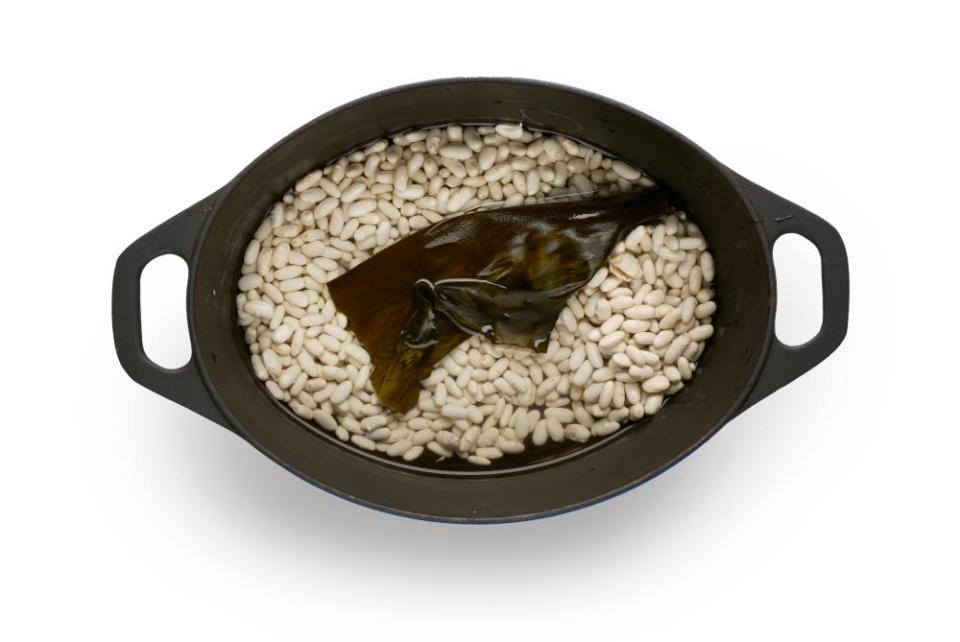
Add the kombu and bring up to a simmer on the hob (alternatively, do this in a saucepan and transfer to an ovenproof dish afterwards). Cover the pan, transfer to the oven and bake for 60-90 minutes, until the beans are soft and the skins come away when you blow on them.
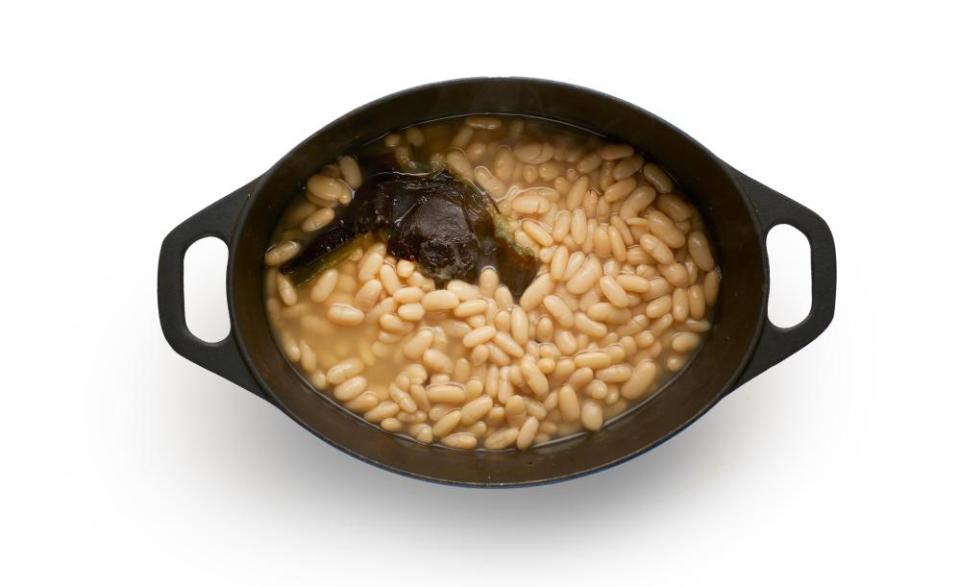
Turn down the oven to 150C (130C fan)/300F/gas 2. Drain enough liquid from the beans into another container until what’s left in the pan comes just above the level of the beans, then stir the English mustard, salt and molasses into the beans.
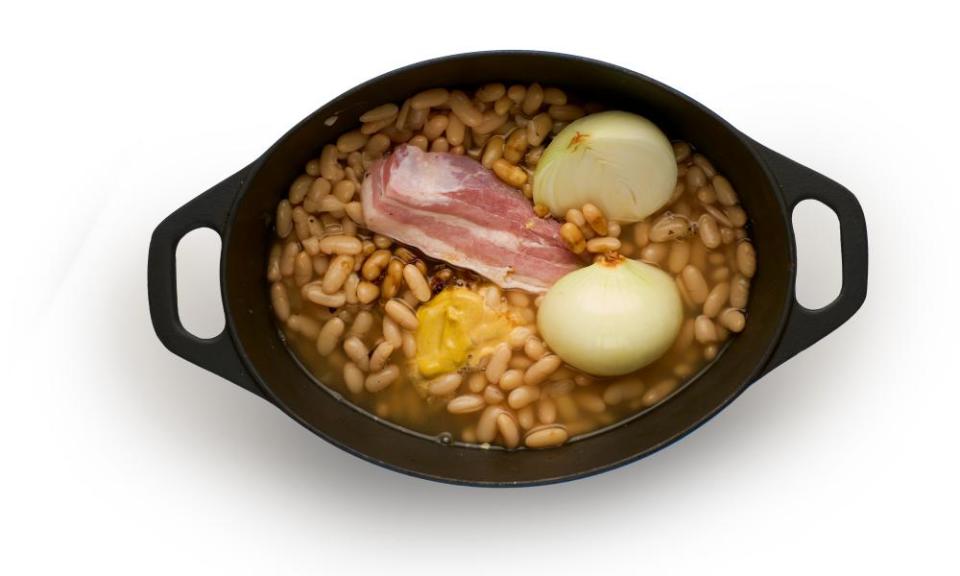
Push the bacon, skin side up if it still has its rind, and the onion cut side down into the beans, cover again and bake for three to four hours longer, until the beans are creamy and soft; if at any stage the beans look like they’re drying out, use the reserved drained liquor to top them up as necessary. Once the beans are done, take off the lid and put back in the oven for a final 45-60 minutes, until the sauce is thick.
Stir in the vinegar and wholegrain mustard, if using, then season to taste, adding more molasses if you’d like it sweeter.
UK readers: click to buy these ingredients from Ocado
• Are Boston, or indeed New England baked beans the noble original, and the tinned version we’ve made our own just a pale and gloopy imitation? How do you make yours, and what do you like to serve them with?

 Yahoo Movies
Yahoo Movies 